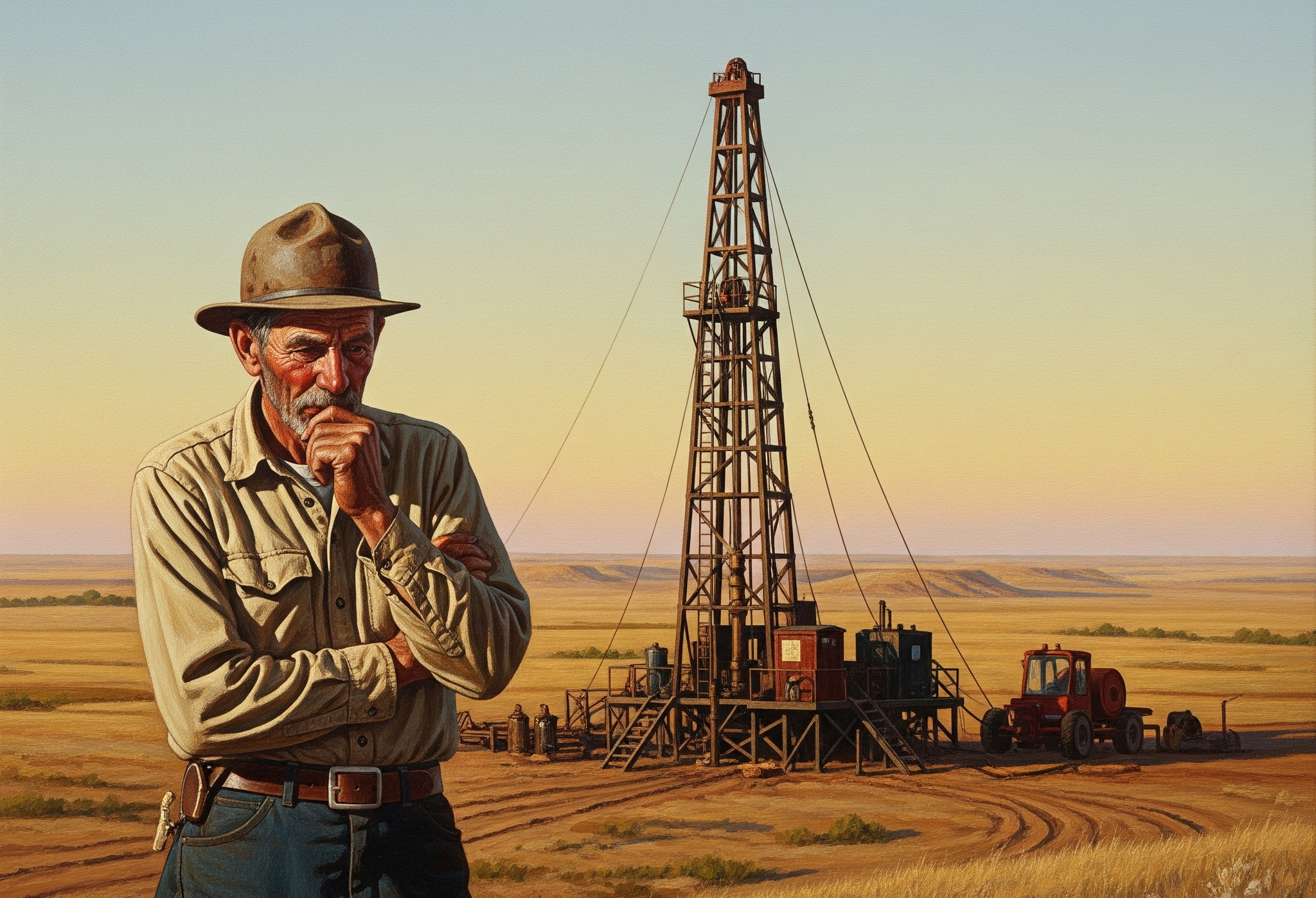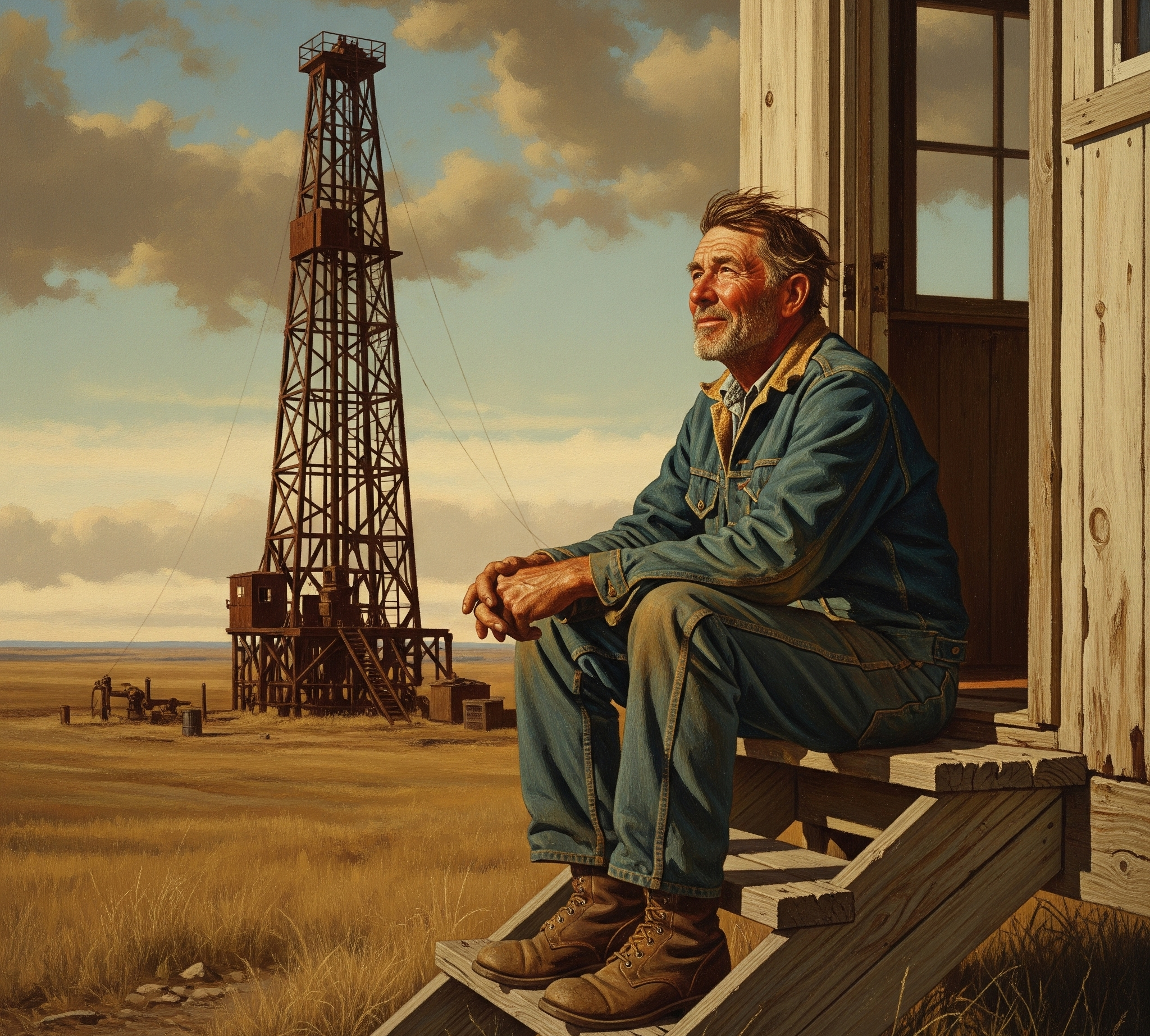The Dust and the Dry Hole

The wind on the South Dakota plains had a mean streak, even in late spring. It whipped grit against the rig’s skeletal legs, a constant, low growl that mirrored the frustration clawing at Jedediah ‘Jed’ Stone. Another dry hole. Or, worse, a non-producing one. Core samples from a thousand feet down hummed with the rich, unmistakable scent of crude, yet when they plunged the pipe, nothing. Not a trickle. Just dead air and the hollow echo of expectation.
Jed wiped sweat from his brow with a greasy sleeve, the taste of dust and diesel on his tongue. For forty years, he’d coaxed black gold from the earth, from Prudhoe Bay to the Permian. He knew the subtle language of the drill bit, the way it chattered against shale, sang through sandstone, or groaned against granite. But this… this was new.
"Another one, boss," shouted Miguel, the roughneck, his voice half-lost to the wind. "Pulled the last section. Still nothing. Just… mud."
Jed nodded, his gaze fixed on the empty pipe. Mud shouldn’t smell like oil. Not rich, sweet crude. Not like a ghost of a reservoir that had simply... vanished. They’d run the seismics twice, sent down every sensor known to man. The data was clear: there was oil. Lots of it. And yet, the wells were bone dry. The same story was coming in from North Dakota, from Montana, even up into Saskatchewan, then Alberta, and finally, the farthest reaches of the northern Canadian fields. A dry epidemic creeping north, swallowing entire production zones.
He pulled out his satellite phone, the signal spotty. "Houston," he grunted into the receiver. "It’s Jed. Rig 7. We got another bust. Cores show high saturation, but the well’s dead. Zero flow. Pressure’s all wrong."
A sigh crackled back, thin and exasperated. "Jed, we’re seeing this across the basin. Engineers are reviewing the new geological models. Could be structural, could be..." The voice trailed off, leaving the unspoken could be you're missing something hanging in the static. Jed just squeezed the phone tighter. He wasn't missing anything. The earth was.
The Impossible Core
A thousand miles south, in the gleaming, climate-controlled tower of OmniCorp, Dr. Anya Sharma stared at the latest geological survey data, a knot tightening in her stomach. Her team had been burning the midnight oil for weeks, trying to make sense of the Great Plains anomaly. Every model, every simulation, every piece of empirical evidence pointed to vast, untapped reserves. Yet, the field reports were unanimous: nothing.
"It's like the oil is just… gone," intern Chen mumbled, scrolling through pressure logs.
"No, Chen," Anya corrected, her voice sharper than intended. "It's not gone. It's there. The cores prove it. But it's not flowing. The permeability is nil. It's as if something is actively preventing its extraction."
A fresh alert pinged. It was Jed’s report from Rig 7, along with an urgent notification about a new core sample being expedited to Houston. "This one's different," the note read. "Strange formations. Like nothing I've seen."
Days later, the core arrived, a pristine cylinder of rock encased in clear polymer. Anya donned gloves and leaned close. The first foot was classic Bakken shale, dark and striated. The next section pulsed with the familiar dark sheen of crude. But then, midway down, it shifted. The crude abruptly became a dense, black mass – a heavy, thixotropic asphalt-like substance. It wasn't merely solidified; it was a viscous, clinging goo that fouled every instrument it touched, refusing to be drawn laterally. It could only be pushed directly downward. And directly below it, separating it from the underlying rock, was a thin, impossibly smooth, almost glassy layer. It looked synthetic. Impervious.
"What in the...?" Anya whispered, running a gloved finger over the surface. It was hard, resisting the slight pressure. "Run this through every spectroscopic analysis we have. I want to know its exact composition. And get me a cross-section of the bitumen-plastic interface. This isn't geology."
The Earth’s Retreat
The results from the lab were impossible. The "plastic" layer wasn't plastic. It was a complex biomineral composite, unlike anything known to science. It mimicked the properties of certain extremophile biofilms but was structured with an intricate, almost crystalline precision. And the bitumen wasn't just naturally solidified; it was a process of rapid, directed transformation, consuming the liquid crude and compacting it into a heavy, unyielding mass, pushing it deeper, away from the typical reservoir formations. This new, viscous asphalt could not be pumped, could not be drawn horizontally; its very nature forced it to retreat in the exact direction of gravity, sealing itself off.

"It's a reverse flow," Anya explained to a room of bewildered executives and geologists, her voice a tight thread of controlled disbelief. Her screen showed a simulation. Instead of oil migrating upwards to accessible traps, it was actively being drawn downwards, solidifying into these impenetrable, buried deposits. "The Earth… it appears to be actively sequestering the hydrocarbons. Forming a cap over them. Sealing them away."
Silence. Then a furious wave of questions. "Sequestering? Dr. Sharma, are you suggesting… the planet is doing this?"
"The data suggests a directed biological and geological response," Anya stated, trying to remain objective. "It's as if ancient carbon, once released, is being systematically returned to a state of deep, inert storage. And that cap... it’s virtually indestructible by current drilling methods. Any attempt to pressurize or move the remaining oil laterally simply causes it to foul equipment or slump further downward."
The board room erupted in a flurry of demands for countermeasures. New drilling tech. Cryo-fracturing. Sonic disintegration. Chemical treatments. Anything to break through this "anomaly." Trillions were at stake. The idea of a conscious Earth, an actively protective Gaia, was too monstrous, too terrifying, too unprofitable to entertain.
Back on the windswept plains, Jed watched the sunrise bleed across the sky, painting the clouds in impossible hues of orange and violet. The new drill bit, a multi-million-dollar experimental alloy, had lasted less than a day before seizing up, coated in the tenacious, black goo. It wasn't just breaking; it was being resisted. A deep, unyielding resistance. The earth felt different under his boots. He felt a profound hum in the ground, a rhythm that was ancient and purposeful, not mechanical.
He picked up a handful of the fine, almost metallic dust that coated everything. The dust that had become a constant presence, dulling the sun, coating the leaves of the hardy prairie grass. It was so subtle, so pervasive. Just like the invisible currents he now imagined pulling the oil deeper, wrapping it in that impossible, synthetic skin.
He looked at the empty pipe of the dry well, then at the vast, indifferent sky. No, not indifferent. Watching. And acting. The frantic calls from Houston, the endless meetings, the desperate attempts to brute-force a solution… they seemed absurd. Like shouting at a mountain to move.
The Earth’s Terms
Weeks turned into months. The crisis deepened. Drill rigs across the entire North American continent, from the Canadian Arctic down into the Gulf Coast, reported the same phenomenon. The oil was literally disappearing, becoming an inert, immovable mass. Then, like a silent, undeniable contagion, reports began flooding in from the Middle East, from Siberia, from the North Sea. The entire global fossil fuel industry was experiencing the same, precise, planetary rejection.
Anya Sharma, now sidelined by OmniCorp for her "unscientific theories," found herself increasingly connecting with a growing network of rogue geologists, climatologists, and biologists. They shared data, simulations, and observations that painted an undeniable picture. The planet was not just reacting; it was acting. The biomineral cap wasn't random; it was a targeted seal. The bitumen wasn't merely solidifying; it was being rapidly polymerized, transformed into an inert, immovable state, effectively locking away millennia of stored carbon. All attempts to reverse the flow or break the seal simply fouled equipment or were met with an unyielding downward pressure.
The Houston skyscrapers still glittered, monuments to a dying age. But the frantic energy within them had turned to a desolate hush. Investment completely dried up. Profits plummeted into the negative. OmniCorp, once a titan, was bleeding cash, its stock plummeting into worthlessness. The entire industry began a major, irreversible crash.

But on the plains, Jed Stone sat on the stoop of his rig’s temporary office, listening to the wind. The air felt cleaner now, somehow. The dust was still there, a constant presence, but it felt less like an invasion and more like a gentle, pervasive hum. The rig was quiet, officially decommissioned. Its towering frame stood like a skeletal monument to human ambition, now humbled.
He thought of the immense, deliberate pressure that had buckled their strongest drills, the unyielding surface that had resisted every chemical. It wasn't angry. It wasn't vengeful. It was simply… resolute. The Earth was just doing what a living organism does when it needs to heal. It was removing a foreign body. It was removing the ancient carbon from the reaches of humans, sealing it away, letting it rest.
Jed looked up at the vast, endless sky, then down at the familiar, dust-laced earth beneath his feet. He felt a strange mix of fear and profound awe. The world wasn't just a resource. It was alive. And it was reminding humanity who was truly in charge. The age of digging was over. The age of listening had just begun.